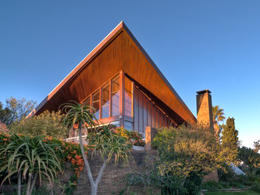ARCHITECTURAL PROJECTS
RESIDENTIAL

When Dutch Kees Bruynzeel moved to South Africa, he wanted his new residence exhibit his profession of timber merchant and the potentials of a timber structure, as well. Bruynzeel in collaboration with the architect Aart Bijl after rejecting complicated shapes, they chosed an existing geometry type, covering the residence with a hyperbolic paraboloid form.
The specific hyperbolic geometry stands over a square plan. The two corners rise with different heights, as the other corners lower to the ground, varying the height of the underlying interior space. In this way there are both big height spaces, reaching six meters height and spaces with lower height. The room dividers with horizontal tops never touch the curved roof, which seems to hover above the large windows of the façade.
The matching of this particular geometry with a residence building was a challenge for the architect. The entrance is on the upper level, where the communal living room and a small library on a mezzanine are placed under the curved roof. The private rooms that need a horizontal roof are placed at the lower floor. Both levels have direct access to the courtyard. A pavilion guest room is connected to the house through a semi open corridor.
The construction of the roof, as it follows a specific type of hyperbolic geometry, was attainable. Straight timbers form the structure of the roof, as the final cover consisted of straight boards, bends to the curvature produced by the assembly of joists. At Bruynzeel house the decking is covered by copper sheeting, and the ceiling is consisted of yellow wood boards, increasing the curve of the roof.
Construction difficulties can occur at the connection of roof with the supports from the ground. In a hyperbolic paraboloid shape two corners point to the sky, as the other two corners point to the ground, capable to support the whole weight of the structure. For the calculation and design of the steel supports from the ground there were made two different studies, one from the local engineers and one from the architect, which was finally realized. The architect, confident for his calculations, stood under the roof during the removing of the scaffolding and the structure did not fortunately collapse. The house remains till nowadays a landmark of the area, causing mixed reactions to the local community.







Architect: Aart Bijl
Construction: 1962
Location: Stellenbosch, South Africa
Edit : Xenia Sotiropoulou
Related articles:
- Die Es House ( 28 December, 2015 )
- Timber structure in Western Cape of South Africa ( 07 January, 2016 )
- Fruit Growers Loft ( 18 January, 2016 )
- St James Box ( 16 March, 2016 )











